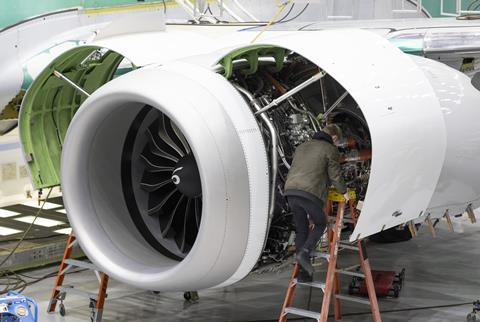GE Aerospace has completed a fuel-nozzle related fix for CFM International Leap turbofans and expects by year-end to introduce fixed high-pressure turbine blades – efforts to address durability problems with its best-selling engines.
The Ohio company is also progressing with development of more-reliable blades for its GE9X, which powers Boeing’s still-not-certificated 777-9.
“The first production [Leap] engine with that [fuel nozzle] fix is already at Airbus, ready to go,” GE Aerospace vice-president of engineering Mohamed Ali said on 7 March.

“The first production set [of new high-pressure turbine blades] is ready in the shop, and we are on track for 2024 introduction for Leap 1As,” he adds.
Some airlines – particularly those operating in dust-filled Middle East airspace – have experienced durability shortcomings with the hotter-burning, more-efficient Leaps, creating operational headaches.
Leap-1As power Airbus A320neo-family jets (one of two power options), while Leap-1Bs are the only engine for Boeing’s 737 Max. GE Aerospace and Safran Aircraft Engines jointly own CFM.
Competing engine maker Pratt & Whitney (P&W) has likewise faced durability problems with its PW1100G, which is the other A320neo power option.
One year ago, in March 2023, GE Aerospace’s Ali said his team was working to address Leap durability issues affecting a “small handful” of components, including fuel nozzles and high-pressure turbine blades.
GE Aerospace clarifies on 11 March it has not modified actual fuel nozzles. “What is changing is the addition of a reverse bleed system that provides cooling air after engine shutdown, thus mitigating the coking of unburned fuel in the nozzles,” it says.
Having addressed that issue, the company is now set to begin delivering Leaps with improved high-pressure turbine blades, Ali says.
To understand and address the blade problem, the company undertook a lengthy test process than involved running a Leap-1A in simulated dusty conditions. Those tests revealed that dust can cause high-pressure turbine blades to develop “wrinkles”, which can be a “precursor for the failure mode that our customers see in the Middle East”, Ali says.
GE Aerospace then ran a Leap-1A with redesigned blades through similar trials. The new blades did not develop the same wrinkles even after running at more than twice as many simulated flight cycles, Ali says. The team is now running a Leap-1B through the tests.
The company previously introduced updated shrouds and drive shafts as part of efforts to improve Leap durability. Despite such issues, Ali insists Leaps have proven more reliable, at this phase in their life cycle, than the CFM56 turbofans that power earlier-generation A320s and 737s.
GE Aerospace is also developing more-reliable GE9X blades.
“We are learning from the previous engines, accelerating the tests… and the first blade improvement is already complete,” Ali says of that effort. “We are now headed into the second dust test ahead of entry into service.”
Boeing has said it aims to have its 777-9 certificated in time for service entry in 2025.
Engine makers have long been challenged to ensure their products meet durability targets when operating in dust-prevalent regions.
But CFM and P&W have seen notable durability issues with their new-generation engines because those powerplants run significantly hotter and at higher pressures – meaning better fuel efficiency – than the turbofan they replace, says analyst Kevin Michaels with AeroDynamic Advisory.
“These engines are running… about 400 degrees hotter than their predecessors. And their pressures are 50% higher,” Michaels said in February, noting that temperatures inside the new powerplants can vastly exceed the melting point of their metallic components. Designers keep the components intact by bathing them in colder air diverted from elsewhere within the engine.
“When you get into dirty air, you clog passages. You melt things that didn’t melt before in V2500s [and] CFM56-5Bs,” Michaels says.
Story updated on 12 March to include a clarification from GE Aerospace about the issue involving fuel nozzles.













































